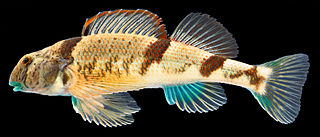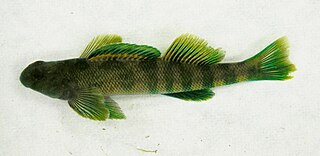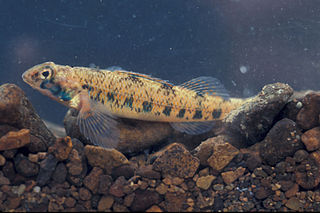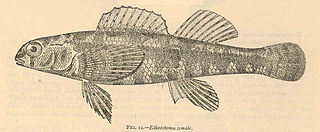
The rainbow darter is a small species of freshwater ray-finned fish, a darter from the subfamily Etheostomatinae, part of the family Percidae, which also contains the perches, ruffes and pikeperches. It is native to North America where it is found in small, fast-moving streams and small to medium-sized rivers. It grows to 2 to 3 inches in length. The species is very sensitive to pollution and silt, staying in clean, pollution-free water. The rainbow darter is easily identified by three dark spots on the back, and blue and orange in the dorsal and anal fins.
The ashy darter is a species of freshwater ray-finned fish, a darter from the subfamily Etheostomatinae, part of the family Percidae, which also contains the perches, ruffes and pikeperches. It is endemic to the eastern United States.
The Bayou darter is a rare species of freshwater ray-finned fish, a darter from the subfamily Etheostomatinae, part of the family Percidae, which also contains the perches, ruffes and pikeperches. It is endemic to western Mississippi in the United States, where it is found only in Bayou Pierre and its tributaries. Its typical habitat is fast-flowing creeks and streams, in riffles and in areas between riffles with firm gravel bottoms. It feeds on small insects and their larvae. Breeding probably takes place twice a year, in spring and late summer. The population of this fish is declining due to loss of suitable habitat. This is caused by siltation and pollution, particularly erosion caused by changes in land use. The International Union for Conservation of Nature has assessed its conservation status as being "endangered".

The blenny darter is a species of freshwater ray-finned fish, a darter from the subfamily Etheostomatinae, part of the family Percidae, which also contains the perches, ruffes and pikeperches. It is a poorly known species which occurs in Alabama and Tennessee where it inhabits swift riffles.

The greenside darter is a species of freshwater ray-finned fish, a darter from the subfamily Etheostomatinae, part of the family Percidae, which also contains the perches, ruffes and pikeperches. It inhabits swift riffles in the eastern United States and southern Ontario.
The Cumberland snubnose darter is a species of freshwater ray-finned fish, a darter from the subfamily Etheostomatinae, part of the family Percidae, which also contains the perches, ruffes and pikeperches. This species is found in the middle Cumberland River drainage in Tennessee, Kentucky, Virginia, North Carolina, Georgia, and Alabama. It is absent in reaches above the Big South Fork, rare in North Carolina, and absent in western tributaries of the Tennessee River. While research on the ecology of E. atripinne is not extensive, what is known is they are usually found in small to medium freshwater streams in gravel riffle areas where their eggs can attach to the substrate and be left unguarded. E. atripinne can be found within a wide range of depths in its environment, leading its being classified as benthopelagic. While its global status is secure, the American Fisheries Society labels it with a status of “Special Concern”.
The emerald darter, is a species of freshwater ray-finned fish, a darter from the subfamily Etheostomatinae, part of the family Percidae, which also contains the perches, ruffes and pikeperches. It is found only in northern and eastern Kentucky and northeastern Tennessee.

The orangefin darter is a species of freshwater ray-finned fish, a darter from the subfamily Etheostomatinae, part of the family Percidae, which also contains the perches, ruffes and pikeperches. It is found in Barren River and Green River systems in Tennessee and Kentucky.
The greenfin darter is a species of freshwater ray-finned fish, a darter from the subfamily Etheostomatinae, part of the family Percidae, which also contains the perches, ruffes and pikeperches. It is endemic to the eastern United States.
The golden darter is a species of freshwater ray-finned fish, a darter from the subfamily Etheostomatinae, part of the family Percidae, which also contains the perches, ruffes and pikeperches. It is found in the upper Tennessee River, one of the over 300 fish species found in Tennessee.
The stone darter is a species of freshwater ray-finned fish, a darter from the subfamily Etheostomatinae, part of the family Percidae, which also contains the perches, ruffes and pikeperches. It is endemic to the eastern United States.

The blueside darter is usually found in the Tennessee River drainage in Tennessee, Alabama, North Carolina, and Virginia, and less commonly found in Bear Creek, Shoal Creek, and Barren Fork.
The stripetail darter is a species of freshwater ray-finned fish, a darter from the subfamily Etheostomatinae, part of the family Percidae, which also contains the perches, ruffes and pikeperches. It is endemic to the eastern United States. It is found in small rivers and streams in the states of Tennessee, Ohio, Kentucky, Illinois, Alabama, Georgia, and Mississippi. Males are a golden-orange color with black barring on the fins, and grow to a length of about 2.8 in (7 cm). This fish feeds on midge larvae and other small invertebrates. It breeds in the spring; eggs are attached to the substrate, often under slab rocks, where they are guarded by the male. The population trend of this fish seems to be stable and it is a common species with numerous sub-populations over a wide range, and the International Union for Conservation of Nature has assessed its conservation status as being of "least concern".

The snubnose darter is a species of freshwater ray-finned fish, a darter from the subfamily Etheostomatinae, part of the family Percidae, which also contains the perches, ruffes and pikeperches. It is endemic to the southeastern United States.
The Citico darter is a threatened species freshwater ray-finned fish, a darter from the subfamily Etheostomatinae, part of the family Percidae, which also contains the perches, ruffes and pikeperches. It is native to Tennessee. This species was formerly subsumed within Etheostoma percnurum. The E. percnurum group now consists of four distinct species: E. percnurum, E. marmorpinnum, E. lemniscatum, and E. sitikuense.

The orangethroat darter is a species of freshwater ray-finned fish, a darter from the subfamily Etheostomatinae, part of the family Percidae, which also contains the perches, ruffes and pikeperches. It is endemic to the central and eastern United States where it is native to parts of the Mississippi River Basin and Lake Erie Basin. Its typical habitat includes shallow gravel riffles in cooler streams and rocky runs and pools in headwaters, creeks, and small rivers, with sand, gravel, rubble, or rock substrates. It forages on the bottom for the aquatic larvae of midges, blackfly, mayfly and caddisfly, as well as isopods and amphipods. Spawning takes place in spring, the selected sites often being the upper stretches of riffles with sandy and gravelly bottoms interspersed with larger cobble. Reproductive success is high in this species. No particular threats have been identified, and the International Union for Conservation of Nature has assessed its conservation status as being of "least concern".
The Tippecanoe darter is a species of freshwater ray-finned fish, a darter from the subfamily Etheostomatinae, part of the family Percidae, which also contains the perches, ruffes and pikeperches. It is endemic to the eastern United States.

Etheostoma zonale, the banded darter, is a species of freshwater ray-finned fish, a darter from the subfamily Etheostomatinae, part of the family Percidae, which also contains the perches, ruffes and pikeperches. It is endemic to the eastern United States. It is mainly found in the Mississippi Basin, ranging from the Verdigris River in Kansas eastward to the Allegheny River in New York, and from the Minnesota River in Minnesota southward to the Ouachita River in Arkansas and the Tennessee River in Alabama. Its typical habitat in small and medium-sized rivers is riffles over cobble or gravel, rock slabs, and small boulders. It feeds on the riverbed on small insect larvae and is itself eaten by birds and larger fish. Males become more colorful and become territorial before spawning which takes place in spring. The females attach the eggs to waterweed. The population trend of this fish seems to be stable, it is a common species with numerous sub-populations over a wide range, no major threats have been identified and the International Union for Conservation of Nature has assessed its conservation status as being of "least concern".
The sickle darter is a recently identified freshwater ray-finned fish, a darter from the subfamily Etheostomatinae, part of the family Percidae, which also contains the perches, ruffes and pikeperches. It is closely related to a well-known darter, Percina macrocephala. Discovered in 2007 in the upper Tennessee River drainage, the sickle darter is a small ,slender bodied, freshwater and benthopelagic fish that most likely feeds on small crayfish and mayflies since it shares a large mouth and long snout with its sister species. The known distribution of the sickle darter is the upper drainage of the Tennessee River of Tennessee, North Carolina and Virginia. It is distinguished from all other Percina darters except its sister species P. macrocephala by a dark suborbital bar and a black bar subtending a medial black spot on the base of the caudal fin. It stays in mostly rocky, sandy, or silty substrates in clear creeks or small rivers in the Appalachian Mountains. The sickle darter spawns in late winter in gravel shoals. It also has large scales which make it different from macrocephala. It's known to be extirpated from most of its home habitat mainly because of agricultural practices that cause siltation and turbidity which causes most populations of the sickle darter to be widely scattered. But where it is found, it can be observed with regularity. Taking all this into consideration, the sickle darter does not have a formal conservation status under any federal or state law although its closely related species is considered a species of concern by the TWRA. Future management plans should include finding more locations of the sickle darter and decreasing further habitat destruction in known distributions by stating it as a fish of concern by state law.
The Tennessee darter is a species of freshwater ray-finned fish, a darter from the subfamily Etheostomatinae, part of the family Percidae, which also contains the perches, ruffes and pikeperches. It is endemic to the eastern United States, where it occurs in the Tennessee River drainage from western Virginia to western Tennessee. It also occurs in the upper Bluestone River drainage in western Virginia. It inhabits current-swept rocky pools and adjacent riffles of creeks and small to medium rivers. This species can reach a length of 6 cm (2.4 in).









